Study on the Influence of Drilling Parameters on the Mechanical Properties and Pressure Relief Effect of Coal Rock
Abstract
1. Introduction
2. Specimen Preparation and Test Scheme
2.1. Specimen Preparation
2.2. Test System
2.3. Test Scheme
3. Experimental Results Analysis
3.1. Influence of Drilling Parameters on Mechanical Properties
3.1.1. Influence of Drilling Layouts on Mechanical Properties
3.1.2. Influence of Drilling Spacings on Mechanical Properties
3.1.3. Influence of Drilling Positions on Mechanical Properties
3.2. Influence of Drilling Parameters on Failure Characteristics of Specimens
3.2.1. Failure Characteristics Analysis of Specimens with Different Drilling Layouts
3.2.2. Failure Characteristics Analysis of Specimens with Different Drilling Spacings
3.2.3. Failure Characteristics Analysis of Specimens with Different Drilling Positions
3.3. Influence of Drilling Parameters on Acoustic Emission Characteristics of Specimens
3.3.1. Acoustic Emission Characteristics of Specimens with Different Drilling Layouts
3.3.2. Acoustic Emission Characteristics of Specimens with Different Drilling Spacings
3.3.3. Acoustic Emission Characteristics of Specimens at Different Drilling Positions
4. Microscopic Cracks and Energy Evolution Law
4.1. Numerical Model Establishment and Mesoscopic Parameter Calibration
4.2. Influence of Different Drilling Parameters on Microscopic Crack Distribution
4.3. Influence of Different Drilling Parameters on Energy Evolution
5. Analysis of Pressure Relief Effect and Discussion
5.1. Evaluation Method of Pressure Relief Effect
5.2. Influence of Drilling Parameters on Pressure Relief Effect
5.2.1. Influence of Drilling Layouts on Pressure Relief Effect
5.2.2. Influence of Drilling Spacings on Pressure Relief Effect
5.2.3. Influence of Drilling Positions on Pressure Relief Effect
5.3. Discussion
6. Conclusions
Author Contributions
Funding
Data Availability Statement
Conflicts of Interest
References
- Pan, Y.; Song, Y.; Liu, J. Pattern, Change and new situation of coal mine rock burst prevention and control in China. Chin. J. Rock Mech. Eng. 2023, 42, 2081–2095. [Google Scholar]
- Dou, L.; Tian, X.; Cao, A.; Gong, S.; He, H.; He, J.; Cai, W.; Li, X. Present situation and problems of coal mine rock burst prevention and control in China. J. China Coal Soc. 2022, 47, 152–171. [Google Scholar]
- Pan, J.; Liu, S.; Ma, W.; Xia, Y.; Wang, S.; Feng, M. Occurrence law and classification prevention of rock burst in coal mines of Shaanxi Province. Coal Sci. Technol. 2024, 52, 95–105. [Google Scholar]
- Zhao, T.B.; Guo, W.Y.; Tan, Y.L.; Yin, Y.C.; Cai, L.S.; Pan, J.F. Case studies of rock bursts under complicated geological conditions during multi-seam mining at a depth of 800 m. Rock Mech. Rock Eng. 2018, 51, 1539–1564. [Google Scholar]
- Gong, F.; He, Z.; Si, X. Experimental study on revealing the mechanism of rockburst prevention by drilling pressure relief: Status-of-the-art and prospects. Geomat. Nat. Hazards Risk 2022, 13, 2442–2470. [Google Scholar]
- Pan, Y. Disturbance response instability theory of rock burst in coal mine. Coal Sci. Technol. 2018, 43, 2091–2098. [Google Scholar]
- GB/T 25217.10-2019; Methods for Test, Monitoring and Prevention of Rock Burst—Part 10: Prevention Method of Drillhole Destressing on Coal-Seam. Standardization Administration of China: Beijing, China, 2019.
- GB/T 25217.2-2010; Methods for Test, Monitoring and Prevention of Rock Burst—Part 2: Classification and Laboratory Test Method on Bursting Liability of Coal. Standardization Administration of China: Beijing, China, 2010.
- Wang, M.; Wang, X.; Xiao, T. Borehole destressing mechanism and determination method of its key parameters in deep roadway. Coal Sci. Technol. 2017, 42, 1138–1145. [Google Scholar]
- Zhao, X.; Zhang, H.; Zhu, W. Fracture evolution around pre-existing cylindrical cavities in brittle rocks under uniaxial compression. Trans. Nonferr. Met. Soc. China 2014, 24, 806–815. [Google Scholar] [CrossRef]
- Lin, P.; Wong, R.H.; Tang, C.A. Experimental study of coalescence mechanisms and failure under uniaxial compression of granite containing multiple holes. Int. J. Rock Mech. Min. Sci. 2015, 77, 313–327. [Google Scholar]
- Jia, C.; Jiang, Y.; Zhang, X.; Wang, D.; Ruan, H.; Wang, C. Laboratory and numerical experiments on pressure relief mechanism of large-diameter boreholes. Chin. J. Geotech. Eng. 2017, 39, 1115–1122. [Google Scholar]
- Wang, P.; Jiang, Y.; Li, P.; Zhou, J.; Zhou, Z. Experimental analysis of pressure relief effect of surrounding rock in high-stress roadways under different drilling parameters. Appl. Sci. 2023, 13, 2511. [Google Scholar] [CrossRef]
- Zhu, Q.; Yin, Y.; Liu, J.; Wen, J.; Shi, J. Mechanism of hysteretic rock burst and outburst induced by surrounding rock stress returning. China Saf. Sci. J. 2017, 27, 99–104. [Google Scholar]
- Zhu, S.; Jiang, F.; Shi, X.; Sun, G.; Zhang, Z.; Cheng, X.; Zhang, H. Energy dissipation index method for determining rock burst prevention drilling parameters. Rock Soil Mech. 2015, 36, 2270–2276. [Google Scholar]
- Yao, J.; Yin, Y.; Zhao, T.; Ren, W.; Qiu, Y.; Guo, W. Segmented enlarged-diameter borehole destressing mechanism and its influence on anchorage support system. Energy Sci. Eng. 2020, 8, 2831–2840. [Google Scholar] [CrossRef]
- Ma, B.; Deng, Z.; Zhao, S.; Li, S. Analysis on mechanism and influencing factors of drilling pressure relief to prevent rock burst. Coal Sci. Technol. 2020, 48, 35–40. [Google Scholar]
- Wang, Q.; Zhang, Y.; Cui, D.; Feng, G.; Du, Y.; Zhang, S.; Chen, H.; Zhang, Z. Effect of Indenter Angle on Bearing Performance of Coal and Accompanying Rocks Under Point Load and Characterization of Mechanical Parameters. Energy Sci. Eng. 2024, 13, 374–391. [Google Scholar]
- Tai, L.; Li, C.; Hu, Y.; Yu, X.; Xu, Z.; Zhang, X.; Lu, S. Experimental study on the significance of pressure relief effect and crack extension law under uniaxial compression of rock-like materials containing drill holes. Sci. Rep. 2024, 14, 1104. [Google Scholar]
- Zhang, Y.; Cui, B.; Wang, Y.; Zhang, S.; Feng, G.; Zhang, Z. Evolution Law of Shallow Water in Multi-Face Mining Based on Partition Characteristics of Catastrophe Theory. Fractal Fract. 2023, 7, 779. [Google Scholar] [CrossRef]
- Yin, Y.; Chen, B.; Zhang, Y.; He, S.; Yao, C.; Liu, C. Experimental study and evaluation on the weakening of bursting liability of coal with boreholes. Eng. Fail. Anal. 2024, 155, 107754. [Google Scholar]
- Yin, Y.; Chen, B.; Han, Y.; Qiu, Y.; Li, C.; Chen, Y. Evolution Law of Stress Field and Pressure Relief Effect of Coal Seam After Drilling. Energy Sci. Eng. 2024, 12, 5493–5503. [Google Scholar]
- Ma, J.; Li, J.; Zhang, S.; Yang, S.; Dong, X.; Liu, D. Numerical simulation analysis of acoustic emission characteristics during the drilling pressure relief process in coal seams under different influencing factors. Processes 2023, 11, 3277. [Google Scholar] [CrossRef]
- Wu, H.; Zhao, G.; Liang, W. Mechanical properties and fracture characteristics of pre-holed rocks subjected to uniaxial loading: A comparative analysis of five hole shapes. Theor. Appl. Fract. Mech. 2020, 105, 102433. [Google Scholar]
- Zhang, S.; Li, Y.; Shen, B.; Sun, X.; Gao, L. Effective evaluation of pressure relief drilling for reducing rock bursts and its application in underground coal mines. Int. J. Rock Mech. Min. Sci. 2019, 114, 7–16. [Google Scholar]
- Nian, J.; Zhao, B.; Zhang, W. Numerical simulation research on the pressure relief and permeability enhancement mechanism of large-diameter borehole in coal seam. Geofluids 2022, 2022, 2926213. [Google Scholar]
- Wang, A.; Gao, Q.; Pan, Y.; Song, Y.; Li, L. Bursting liability and energy dissipation laws of prefabricated borehole coal samples. J. China Coal Soc. 2021, 46, 959–972. [Google Scholar]
- Zuo, J.; Hu, S.; Zhou, X.; Zhang, C.; Guo, Y. Effective evaluation of pressure relief drilling layout for reducing rock bursts and sensitive factor analysis. Arab. J. Geosci. 2021, 14, 2643. [Google Scholar]
- Gong, F.; He, Z.; Jiang, Q. Internal mechanism of reducing rockburst proneness of rock under high stress by real-time drilling pressure relief. Rock Mech. Rock Eng. 2022, 55, 5063–5081. [Google Scholar]
- He, Z.; Gong, F.; Luo, S. Evaluation of the rock burst proneness of red sandstone with prefabricated boreholes: An experimental study from the energy storage perspective. Geomat. Nat. Hazards Risk 2021, 12, 2117–2154. [Google Scholar]
- Lyu, J.; Qi, L.; Pan, Y.; Dai, L.; Tang, Z.; Wang, X. Study on the pressure relief energy dissipation law of variable-diameter boreholes in roadway surrounding rock under dynamic and static loads. PLoS ONE 2024, 19, e0306449. [Google Scholar]
- Chen, M.; Zhang, Y.; Zang, C.; Zhang, G.; Li, Q.; Jiang, B. Experimental investigation on pressure relief mechanism of specimens with prefabricated reaming boreholes. Rock Mech. Rock Eng. 2023, 56, 2949–2966. [Google Scholar]
- Qi, Y.; Jing, H.; Meng, B.; Dong, Z.; Liu, D. Experimental modelling on size effect of pressure relief hole. J. Min. Saf. Eng. 2018, 35, 538–544. [Google Scholar]
- Zhang, T.; Jing, C.; Zhang, L.; Ji, X.; Pan, H. Strain localization characteristics of perforation failure of perforated specimens. Coal Sci. Technol. 2020, 45, 4087–4094. [Google Scholar]
- Guo, J.; Feng, Z.; Li, X. Evolution of microcracks and energy of granite during shear test with PFC3D. Coal Sci. Technol. 2024, 52, 60–70. [Google Scholar]
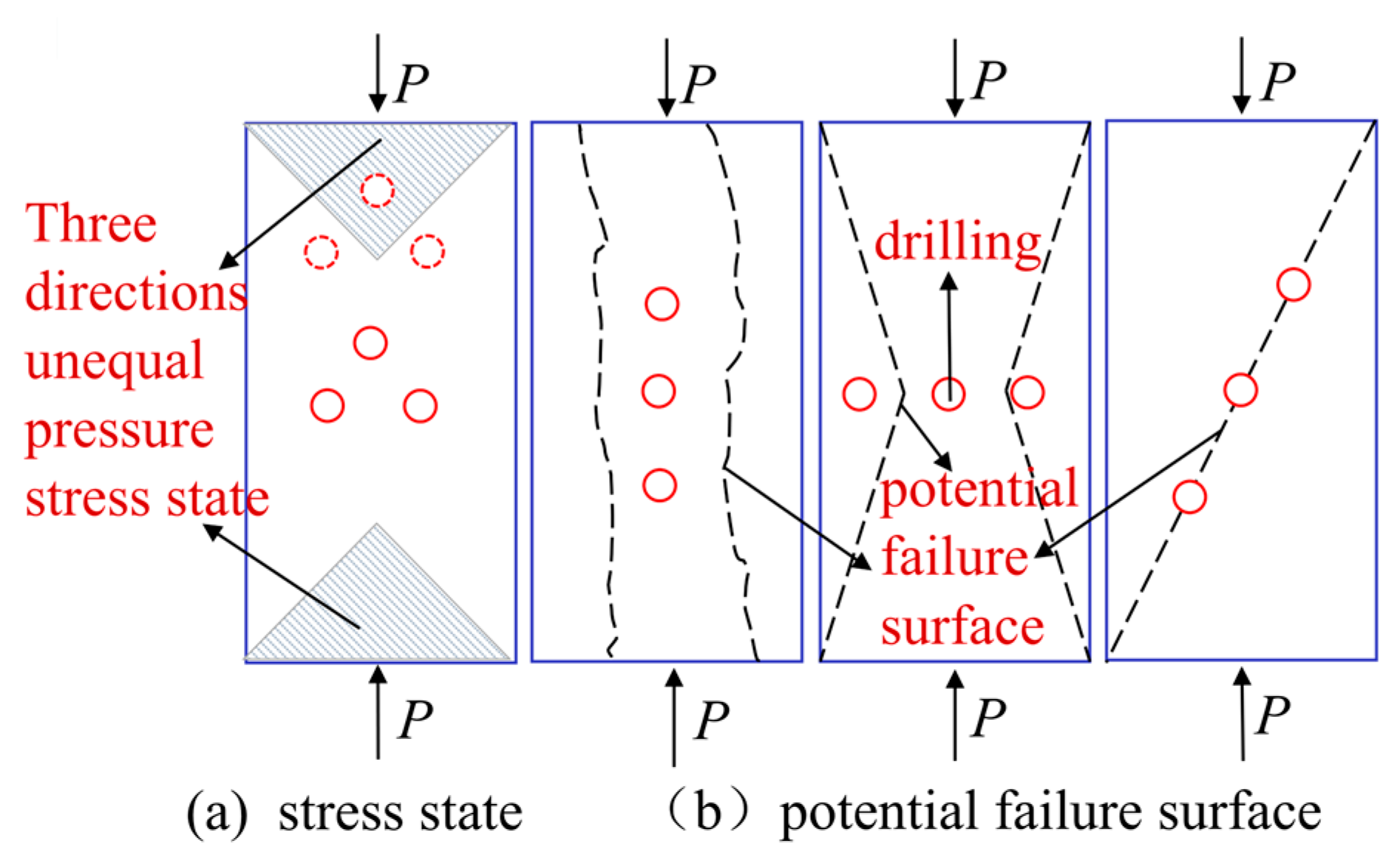
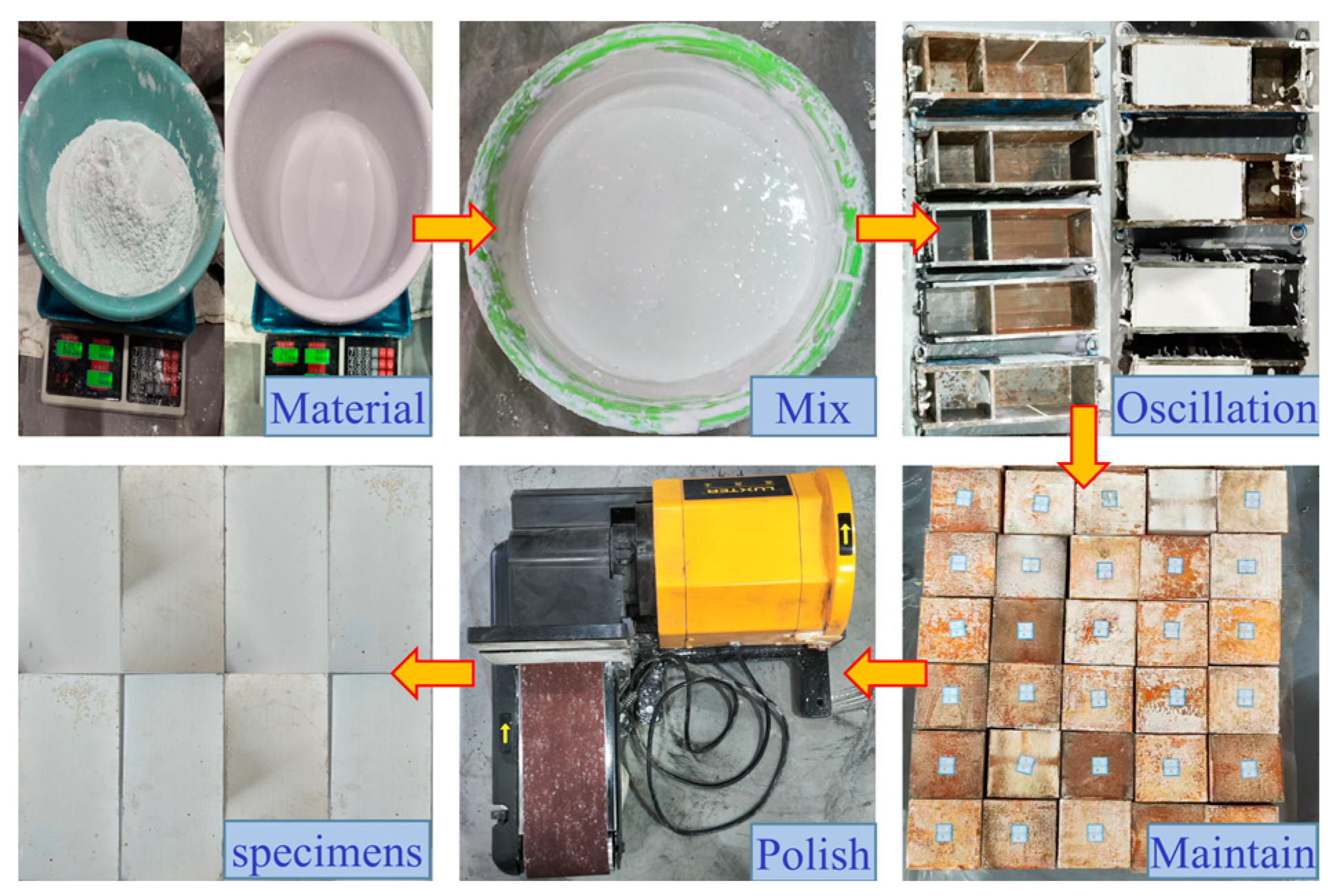



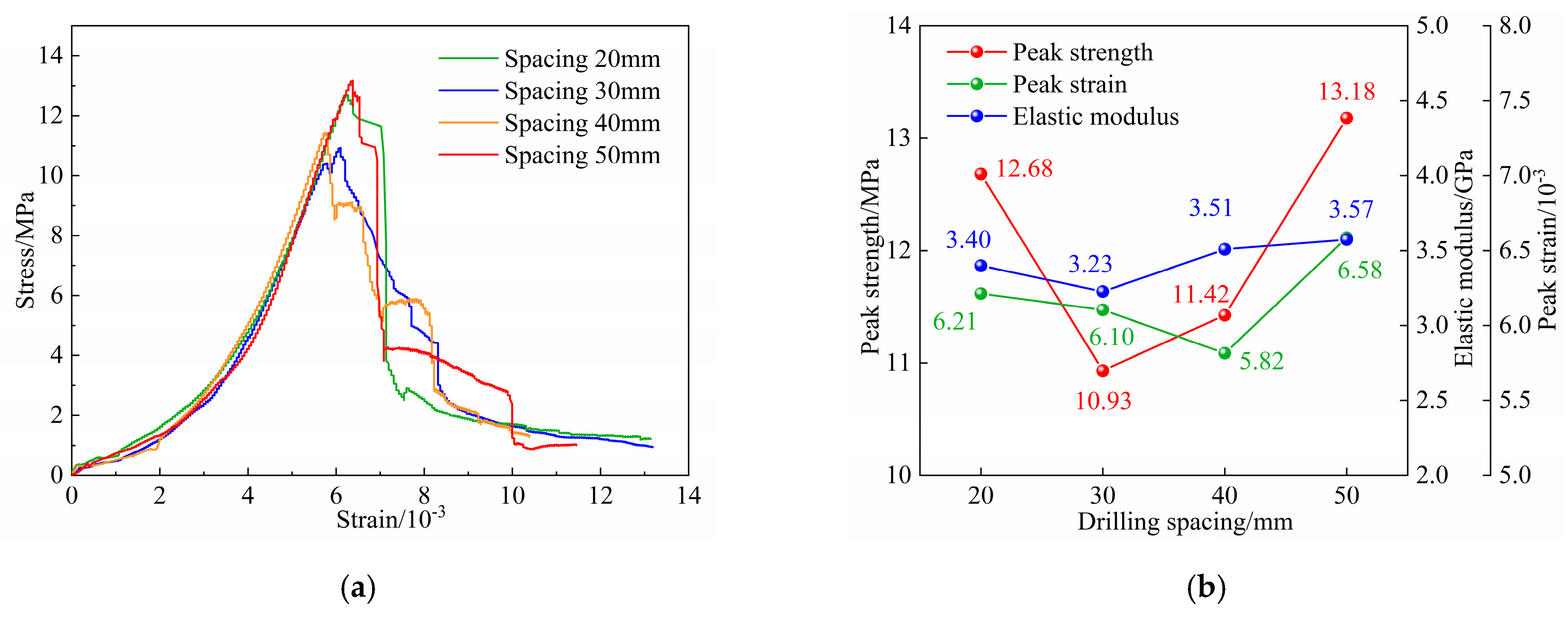

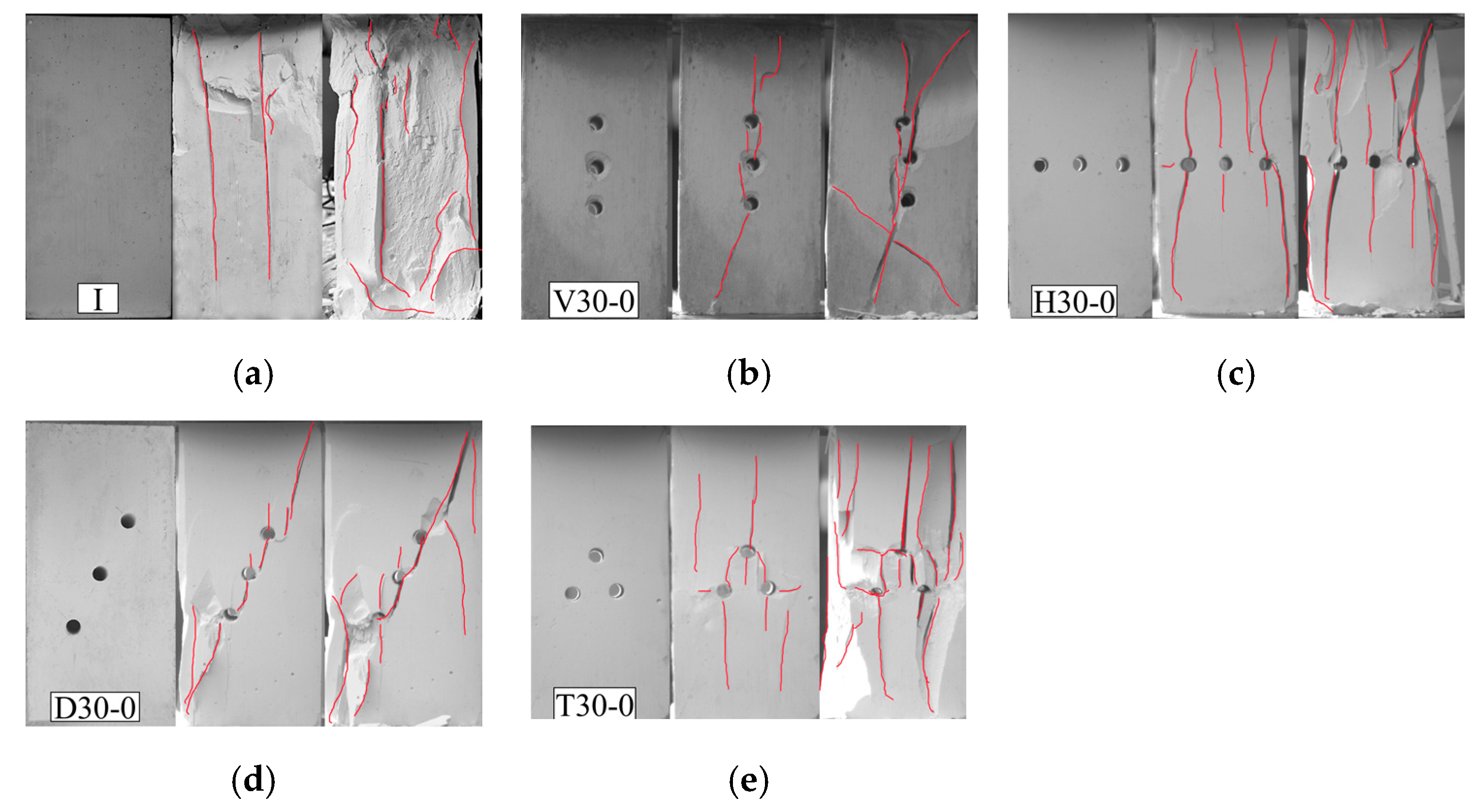





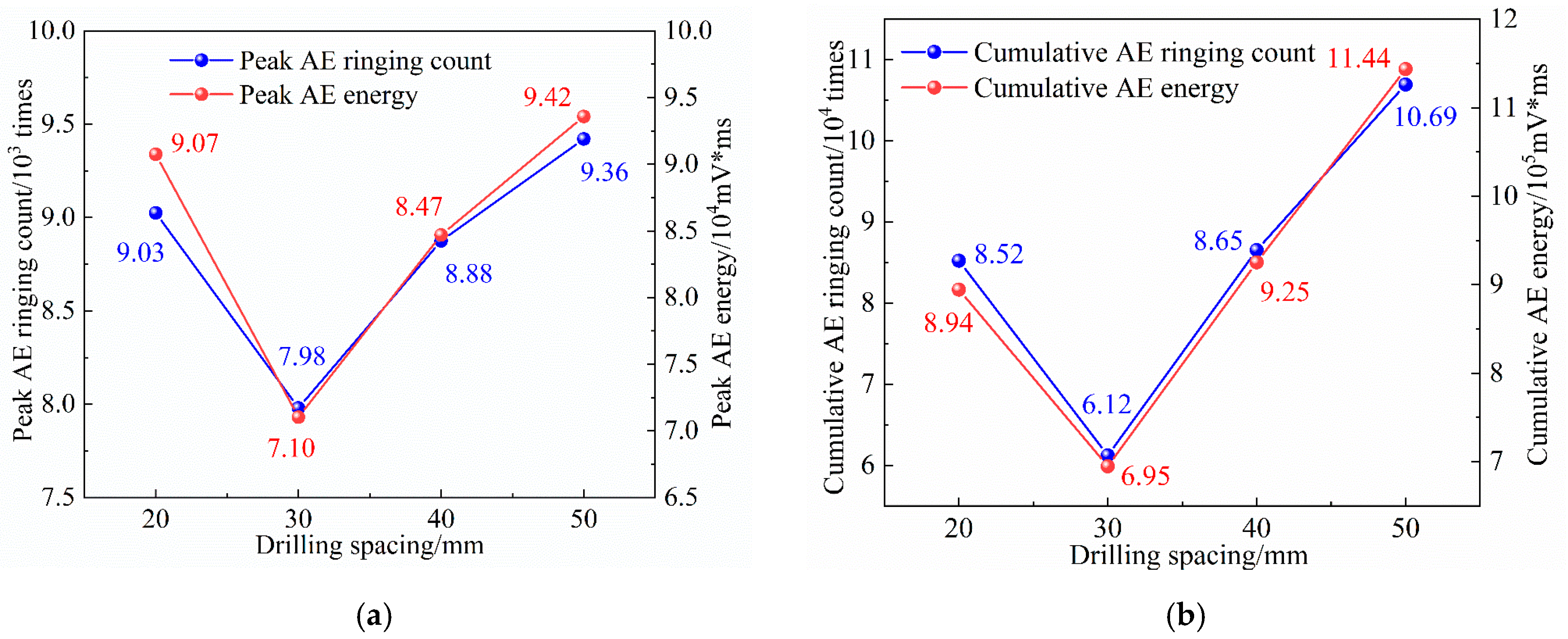



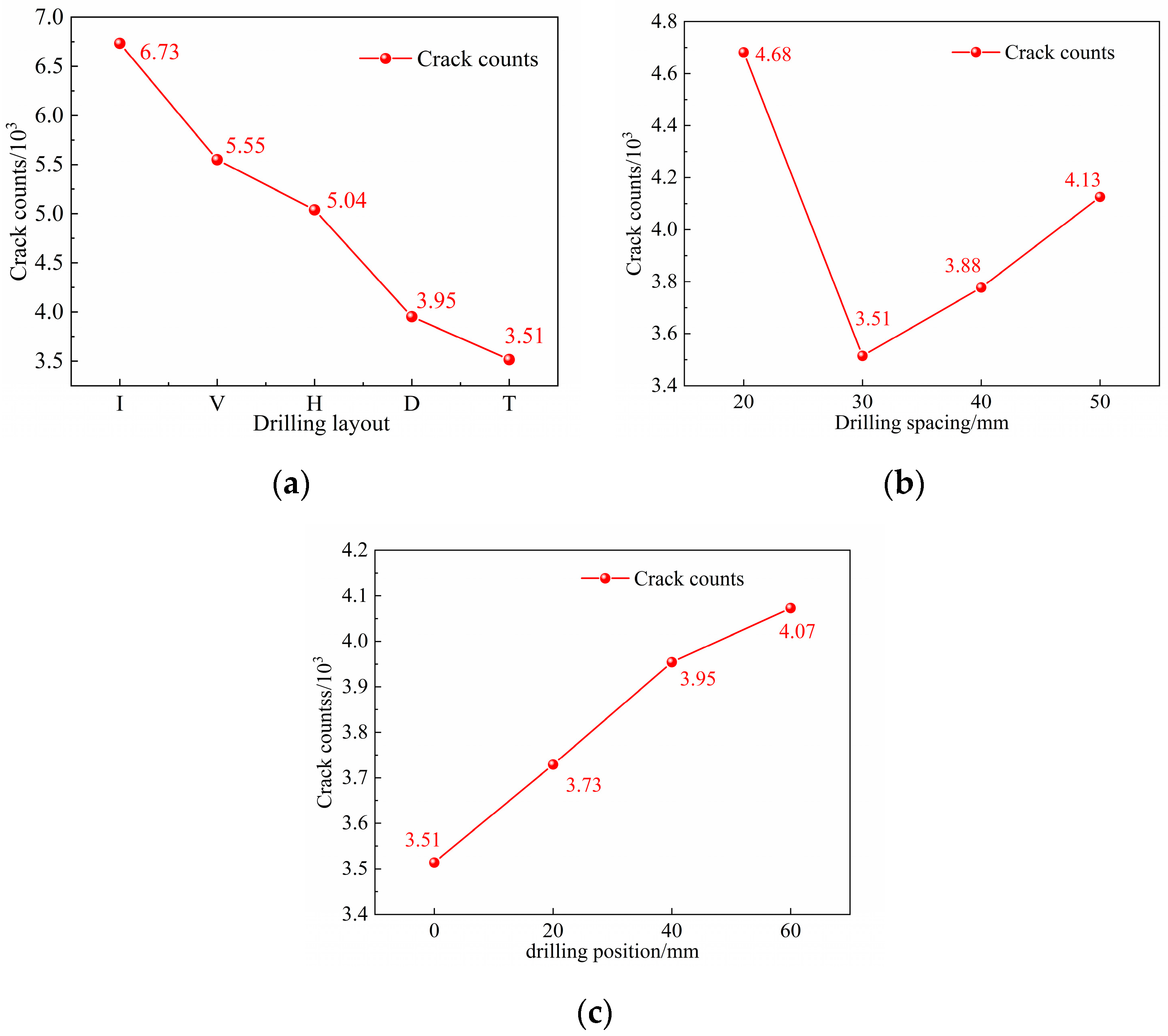
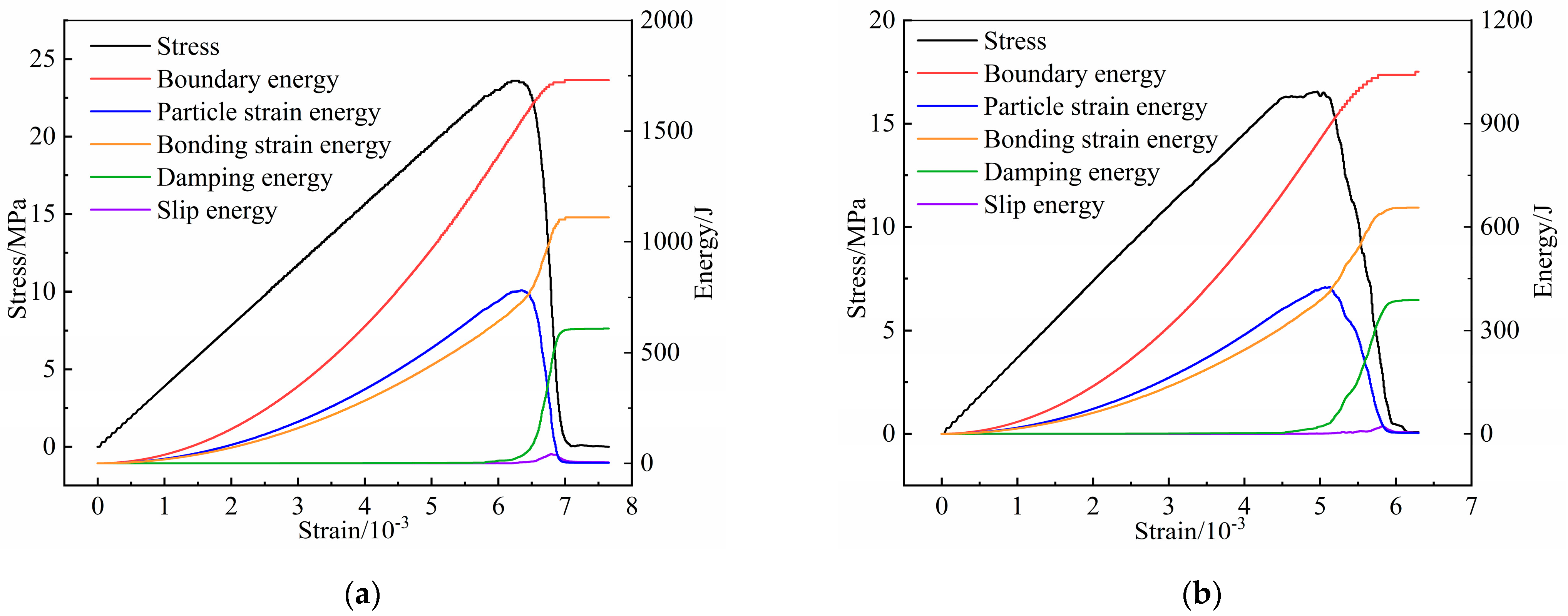
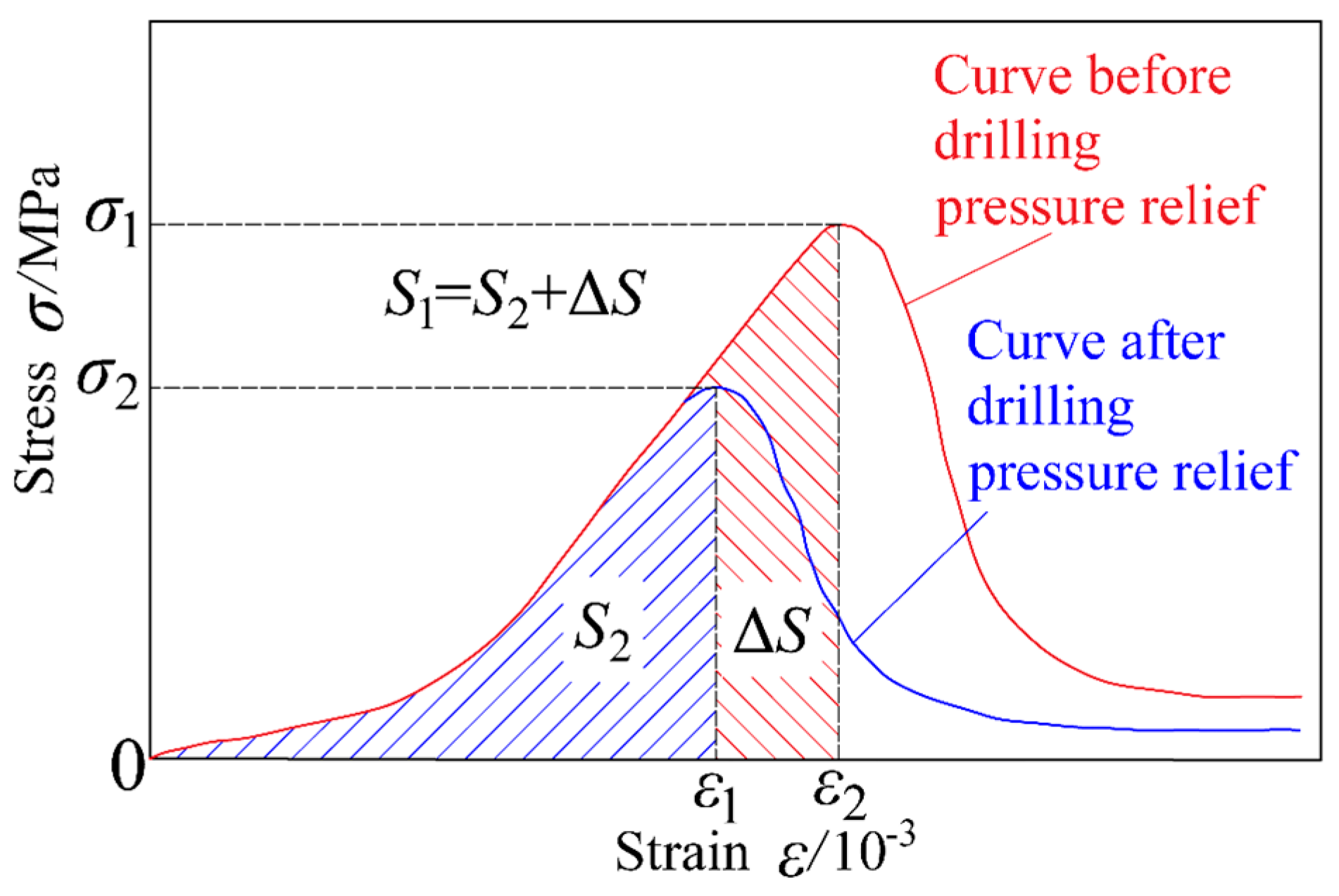
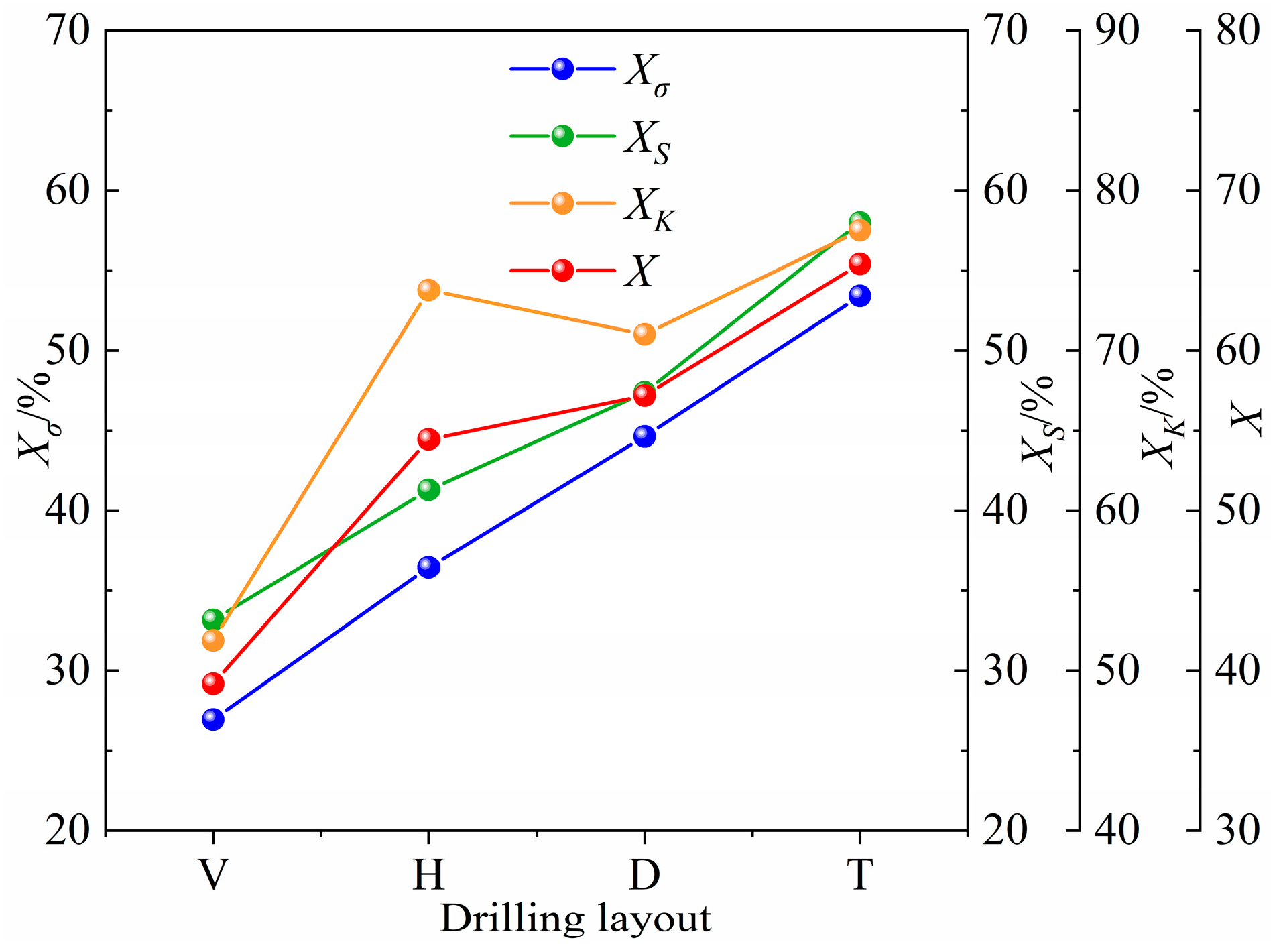

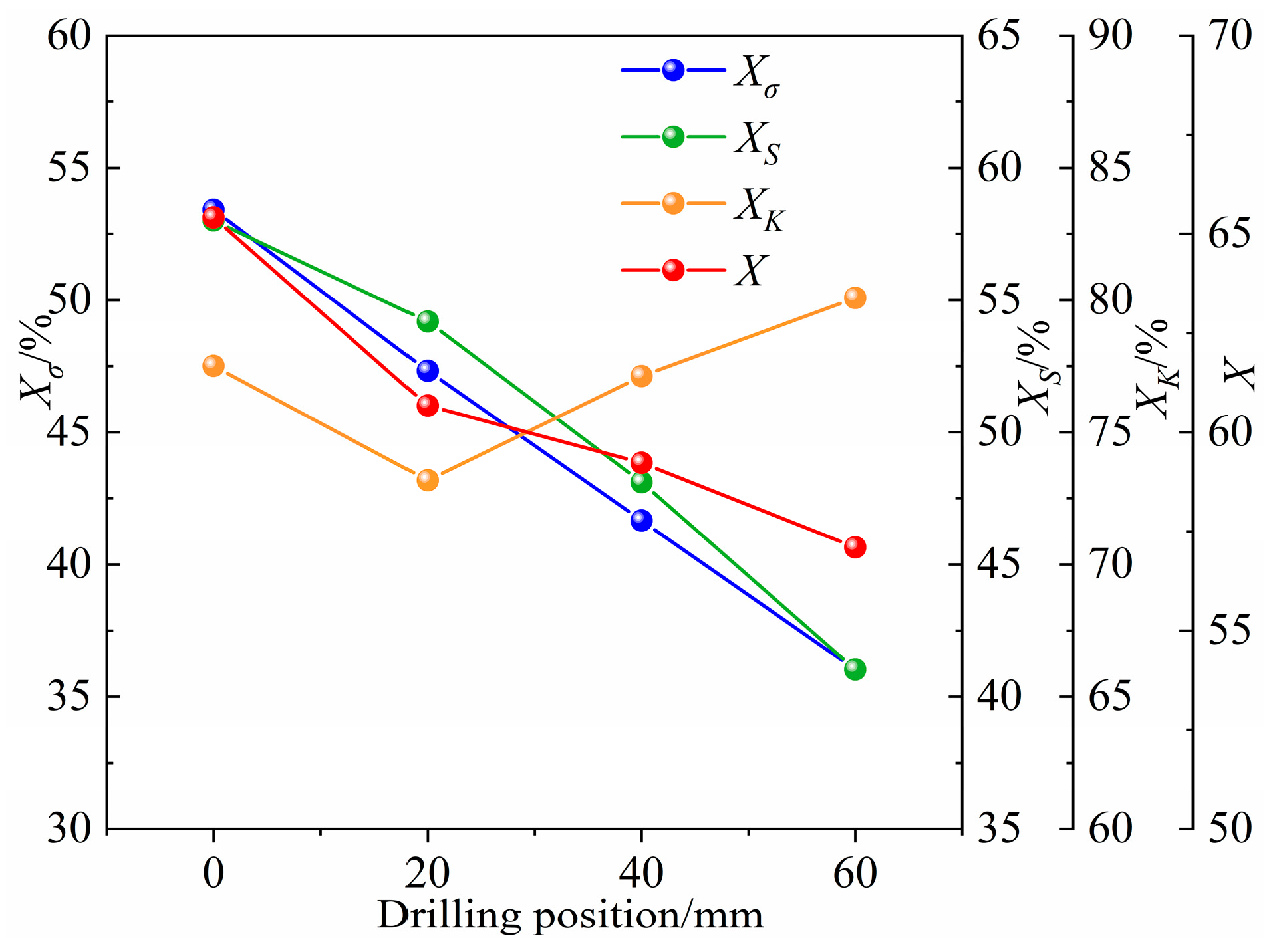
| Specimen Number | Density/(g/cm3) | Rc/MPa | DT/ms | KE | WET | Elastic Modulus/GPa |
|---|---|---|---|---|---|---|
| 1 | 1.51 | 21.34 | 64.5 | 7.47 | 6.78 | 4.53 |
| 2 | 1.52 | 21.92 | 47.7 | 5.58 | 7.55 | 4.47 |
| 3 | 1.50 | 21.17 | 84.2 | 7.37 | 6.21 | 4.70 |
| Average value | 1.51 | 21.48 | 65.47 | 6.81 | 6.85 | 4.57 |
| Test Scheme | Drilling Layout | Drilling Spacing/mm | Drilling Position/mm |
|---|---|---|---|
| I | I, H, T, D, V | 30 | 0 |
| II | T | 20, 30, 40, 50 | 0 |
| III | T | 30 | 0, 20, 40, 60 |
| Parameter | Value | Parameter | Value |
|---|---|---|---|
| Density (kg/m3) | 1510 | Stiffness ratio | 0.8 |
| Rmin (mm) | 0.5 | Parallel-bond modulus/GPa | 1.7 |
| Rmax (mm) | 0.75 | Parallel-bond cohesion strength/MPa | 12.0 |
| Porosity | 0.12 | Parallel-bond tensile strength/MPa | 5.5 |
| Friction coefficient | 0.5 | Friction Angle/° | 38 |
| Specimen Shape | Peak Stress /MPa | Boundary Energy/J | Particle Strain Energy/J | Bonding Strain Energy/J | Damping Energy/J | Slip Energy/J |
|---|---|---|---|---|---|---|
| Intact | 23.59 | 1730.02 | 778.32 | 1110.56 | 608.21 | 39.91 |
| V30-0 | 19.41 | 1458.7 | 607.89 | 944.39 | 409.76 | 30.09 |
| H30-0 | 19.08 | 1311.74 | 528.92 | 867.43 | 434.79 | 31.91 |
| D30-0 | 17.18 | 1084.87 | 473.44 | 707.91 | 371.98 | 21.43 |
| T30-0 | 16.5 | 1050.90 | 425.7 | 656.11 | 389.04 | 20.7 |
| T20-0 | 17.28 | 1080.11 | 468.04 | 709.11 | 363.02 | 20.61 |
| T40-0 | 16.71 | 1090.33 | 448.51 | 716.44 | 370.23 | 16.9 |
| T50-0 | 18.34 | 1238.12 | 541.04 | 813.55 | 420.08 | 15.27 |
| T30-20 | 17.15 | 1137.51 | 507.78 | 739.83 | 390.39 | 20.75 |
| T30-40 | 18.29 | 1197.76 | 518.5 | 800.87 | 389.98 | 11.33 |
| T30-60 | 18.83 | 1320.82 | 554.5 | 851.79 | 463.42 | 22.28 |
| Specimen Type | Δσ/MPa | Xσ/% | S/10−3 | ΔS/10−3 | XS/% | Ax/10−3 | KE | XK/% | X |
|---|---|---|---|---|---|---|---|---|---|
| Intact | - | 54.62 | - | - | 10.77 | 5.07 | |||
| Vertical | 6.32 | 26.93 | 36.50 | 18.12 | 33.17 | 14.98 | 2.44 | 51.88 | 39.18 |
| Horizontal | 8.55 | 36.45 | 32.07 | 22.55 | 41.29 | 24.14 | 1.33 | 73.77 | 54.45 |
| Diagonal | 10.47 | 44.64 | 28.73 | 25.89 | 47.40 | 19.58 | 1.47 | 71.01 | 57.45 |
| Triangular | 12.53 | 53.41 | 22.93 | 31.69 | 58.01 | 20.14 | 1.14 | 77.51 | 65.41 |
| Specimen Type | Δσ/MPa | Xσ/% | S/10−3 | ΔS/10−3 | XS/% | Ax/10−3 | KE | XK/% | X |
|---|---|---|---|---|---|---|---|---|---|
| Intact | - | 54.62 | - | - | 10.77 | 5.07 | |||
| T20-0 | 10.78 | 45.95 | 26.93 | 27.69 | 50.70 | 20.26 | 1.33 | 73.77 | 59.66 |
| T30-0 | 12.53 | 53.41 | 22.93 | 31.69 | 58.01 | 20.14 | 1.14 | 77.51 | 65.41 |
| T40-0 | 12.03 | 51.31 | 21.52 | 33.10 | 60.60 | 16.70 | 1.29 | 74.56 | 64.09 |
| T50-0 | 10.28 | 43.82 | 27.15 | 27.47 | 50.30 | 17.62 | 1.54 | 69.63 | 57.06 |
| Specimen Type | Δσ/MPa | Xσ/% | S/10−3 | ΔS/10−3 | XS/% | Ax/10−3 | KE | XK/% | X |
|---|---|---|---|---|---|---|---|---|---|
| Intact | - | - | 54.62 | - | - | 10.77 | 5.07 | ||
| T30-0 | 12.53 | 53.41 | 22.93 | 31.69 | 58.01 | 20.14 | 1.14 | 77.51 | 65.41 |
| T30-20 | 11.10 | 47.32 | 25.02 | 29.60 | 54.19 | 18.40 | 1.36 | 73.18 | 60.67 |
| T30-40 | 9.77 | 41.66 | 28.34 | 26.28 | 48.11 | 24.40 | 1.16 | 77.12 | 59.23 |
| T30-60 | 8.45 | 36.03 | 32.21 | 22.41 | 41.03 | 31.75 | 1.01 | 80.08 | 57.10 |
Disclaimer/Publisher’s Note: The statements, opinions and data contained in all publications are solely those of the individual author(s) and contributor(s) and not of MDPI and/or the editor(s). MDPI and/or the editor(s) disclaim responsibility for any injury to people or property resulting from any ideas, methods, instructions or products referred to in the content. |
© 2025 by the authors. Licensee MDPI, Basel, Switzerland. This article is an open access article distributed under the terms and conditions of the Creative Commons Attribution (CC BY) license (https://creativecommons.org/licenses/by/4.0/).
Share and Cite
Zhang, Y.; Chen, Y.; Zhang, S.; Feng, G.; Wang, Y.; Li, S.; Wang, Q.; Wang, B.; Zhao, L. Study on the Influence of Drilling Parameters on the Mechanical Properties and Pressure Relief Effect of Coal Rock. Processes 2025, 13, 993. https://doi.org/10.3390/pr13040993
Zhang Y, Chen Y, Zhang S, Feng G, Wang Y, Li S, Wang Q, Wang B, Zhao L. Study on the Influence of Drilling Parameters on the Mechanical Properties and Pressure Relief Effect of Coal Rock. Processes. 2025; 13(4):993. https://doi.org/10.3390/pr13040993
Chicago/Turabian StyleZhang, Yujiang, Yexing Chen, Shuai Zhang, Guorui Feng, Yuguo Wang, Shule Li, Qian Wang, Bo Wang, and Liang Zhao. 2025. "Study on the Influence of Drilling Parameters on the Mechanical Properties and Pressure Relief Effect of Coal Rock" Processes 13, no. 4: 993. https://doi.org/10.3390/pr13040993
APA StyleZhang, Y., Chen, Y., Zhang, S., Feng, G., Wang, Y., Li, S., Wang, Q., Wang, B., & Zhao, L. (2025). Study on the Influence of Drilling Parameters on the Mechanical Properties and Pressure Relief Effect of Coal Rock. Processes, 13(4), 993. https://doi.org/10.3390/pr13040993







